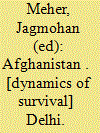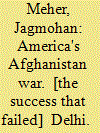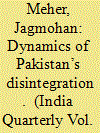|
|
|
Sort Order |
|
|
|
Items / Page
|
|
|
|
|
|
|
| Srl | Item |
| 1 |
ID:
080246


|
|
|
|
|
| Publication |
New Delhi, Kalpaz Publications, 2008.
|
| Description |
311p.hbk
|
| Standard Number |
9788178356402
|
|
|
|
|
|
|
|
|
|
|
|
Copies: C:1/I:0,R:0,Q:0
Circulation
| Accession# | Call# | Current Location | Status | Policy | Location |
| 053079 | 958.1/MEH 053079 | Main | On Shelf | General | |
|
|
|
|
| 2 |
ID:
049800


|
|
|
|
|
| Publication |
DelhI, Kalpaz Publications, 2004.
|
| Description |
325p.hbk
|
| Standard Number |
8178352621
|
|
|
|
|
|
|
|
|
|
|
|
Copies: C:1/I:0,R:0,Q:0
Circulation
| Accession# | Call# | Current Location | Status | Policy | Location |
| 047485 | 958.1046/MEH 047485 | Main | On Shelf | General | |
|
|
|
|
| 3 |
ID:
142003


|
|
|
|
|
| Summary/Abstract |
This article attempts to answer two questions: (a) what led to the psychological fissure of the East Pakistanis? And (b) how did the psychological fissure culminate into their physical separation? To answer the first question, the study examines six variables of perpetual antagonism between East and West Pakistan, that is, geographical absurdity, constitutional confusions and military takeover, economic disparity, language issues, political factionalism and military dynamics, and establishes that the conjuncture of all these factors (rather than the role of India or outside actors which have often been exaggerated ignoring the internal dynamics) constituted the dynamics of Pakistan’s disintegration in 1971. Then it discusses West Pakistan’s genocide against the East Pakistanis and the Indian intervention as immediate factors for Pakistan’s physical separation. The study finds that the Indian action reinforced the existing variables, accelerated the creation of Bangladesh and ended civil strife. Paradoxically, outside actors such as the United States, Soviet Union and China had only a limited impact on the sources and escalation of the East–West divide. The lessons of 1971 are relevant for the inner workings of federalism, especially with disconnected geographical boundaries.
|
|
|
|
|
|
|
|
|
|
|
|
|
|
|
|
| 4 |
ID:
117616


|
|
|
|
|
| Publication |
2012.
|
| Summary/Abstract |
Pakistan's obsession of searching for a 'strategic depth' across the Durand Line in Afghanistan and a 'Muslim Space' in the Indian state of Jammu and Kashmir has proved to be a devastating policy for the country in pursuit of which its military-intelligence establishment implanted the seeds of Islamism, extremism and state-sponsored terrorism on both sides of their borders. This strategic overstretch, though driven by a strong military sense of geo-politics among its largely military rulers, is embedded in the country's unrealistic yearnings, out of place perceptions and false grievances. The army outsourced its ill-conceived strategy to jihadi organisations and religious institutions and allowed local militias, terrorist groups, guerrilla armies and other non-state actors to emerge in different parts of the country who afterwards claim political and religious authority. Rawalpindi (army headquarters) supported these terrorists as a cheap way to keep India and Afghanistan off balance. But over the years, they have metamorphosed into a menace and the more powerful terrorist groups-which are also the more radical ones-have outgrown their handlers; fatally weakening the political institutions, declining the role of the state and creating monsters that threaten to devour Pakistani society. In the process, the failure of the state apparatus is creating a culture of impunity and ultimately leading to the breakdown of the rule of law in the country. Clearly, ongoing fragility appears to be a prelude to a failed state. Thus, the extremists' growth and power in Pakistani society are a direct result of its policy towards India and Afghanistan. What is required is a four-dimensional approach to promote liberal democracy, to reduce the role of military, to reform madrassah, and to emphasise on economic development through cross-border trade with India and Afghanistan. The Pakistani strategic obsession has large-scale security implications both for its neighbours and the international community at large, and hence, requires closer scrutiny and analysis.
|
|
|
|
|
|
|
|
|
|
|
|
|
|
|
|
|
|
|
|
|